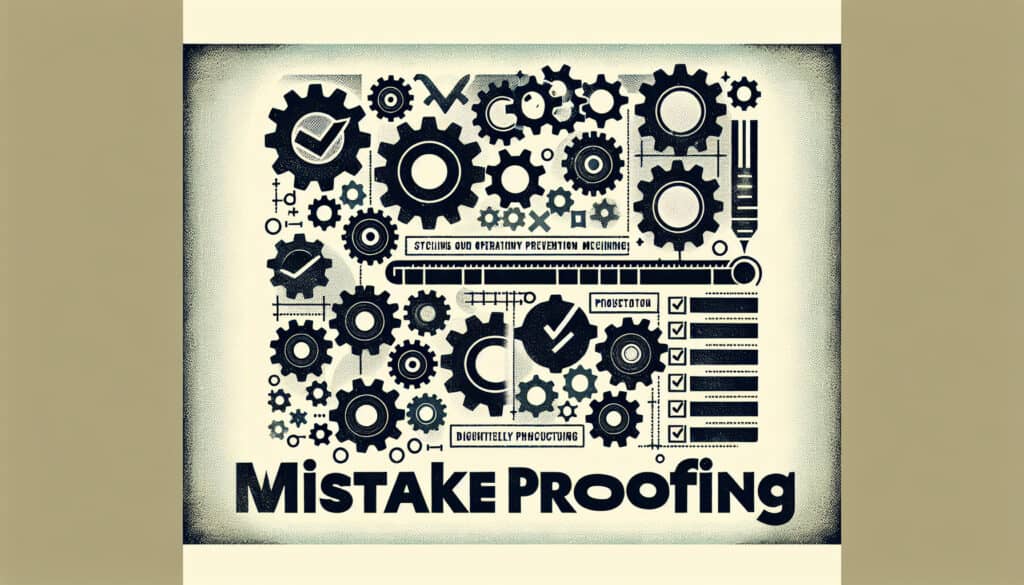Para evitar que se produzcan errores en un proceso.
- Metodologías: Lean Sigma, Fabricación, Calidad
A prueba de errores (Poka-Yoke)

A prueba de errores (Poka-Yoke)
- Mejora continua, Diseño para la fabricación (DfM), Prevención de errores, Manufactura esbelta, Poka-yoke, Mejora de procesos, Seguro de calidad, Control de calidad, Seis Sigma
Objetivo:
Cómo se utiliza:
- A Japanese term that means 'mistake-proofing'. It is a technique for preventing errors by designing processes and products in a way that makes it impossible for errors to occur. For example, a USB plug can only be inserted in one direction.
Ventajas
- Prevents errors from occurring, which improves quality and safety; Can reduce costs and improve efficiency.
Contras
- Can be difficult to implement for all types of errors; May not be a substitute for training and supervision.
Categorías:
- Lean Sigma, Fabricación, Calidad
Ideal para:
- Designing products and processes in a way that prevents errors from occurring, such as in a manufacturing assembly line.
Poka-Yoke techniques can be applied in various sectors such as automotive manufacturing, healthcare, electronics, and food processing, where minimizing errors is paramount. During the design phase, engineers and designers collaborate to identify potential failure points within a process or product, enabling the implementation of fail-safe mechanisms before production begins. For instance, in a manufacturing assembly line, fixtures can be designed to guide components into correct positions, while in software development, user interfaces can include prompts that prevent data entry errors. Quality control teams often integrate Poka-Yoke principles to enhance inspection processes by employing checklists or automated systems that flag inconsistencies. This methodology can be initiated by project managers or quality engineering teams, encouraging involvement from cross-functional teams including production workers who can provide insights on practical challenges faced on the shop floor. Industries such as healthcare utilize Poka-Yoke through medication dispensing systems that ensure patients receive the correct dosage, emphasizing patient safety and operational efficiency. The implementation of these techniques not only enhances quality but also leads to significant cost savings, as the expenses associated with rework, waste, and customer complaints diminish. By embedding error-prevention measures directly into processes, organizations cultivate a culture of continuous improvement, reinforcing accountability among employees while fostering operational reliability.
Pasos clave de esta metodología
- Identify potential failure modes in processes or products.
- Evaluate the impact and frequency of identified failure modes.
- Develop solutions that eliminate or reduce the likelihood of errors occurring.
- Implement Poka-Yoke devices or methods in the design process.
- Test the effectiveness of the implemented solutions under real conditions.
- Iterate on the design based on feedback and error occurrence rates.
- Educate users about the Poka-Yoke features in the design.
- Establish a monitoring system for ongoing error detection and prevention.
Consejos profesionales
- Integrate error detection sensors in assembly lines to provide immediate feedback on incorrect part positioning or insertion to prevent defects.
- Design interchangeable components that can only fit in one way or are distinguishable by tactile cues, reducing the risk of assembly errors.
- Implement standardized work processes with visual aids and limits on part usage to curb mistakes during repetitive tasks on the manufacturing floor.
Leer y comparar varias metodologías, recomendamos el
> Amplio repositorio de metodologías <
junto con otras más de 400 metodologías.
Sus comentarios sobre esta metodología o información adicional son bienvenidos en la dirección sección de comentarios ↓ , así como cualquier idea o enlace relacionado con la ingeniería.
Contexto histórico
1950
1950
1950
1960
1960
1960
1960
1950
1950
1950
1958
1960
1960
1960
1960
(si se desconoce la fecha o no es relevante, por ejemplo "mecánica de fluidos", se ofrece una estimación redondeada de su notable aparición)















Publicaciones relacionadas
Sistema de Ejecución de Fabricación (MES)
Plan de control de la fabricación
Pruebas manuales
Tablas de evaluación de la manipulación manual (MAC)
ManTRA (Herramienta de evaluación de riesgos en las tareas manuales)
Fabricación contra stock (MTS)